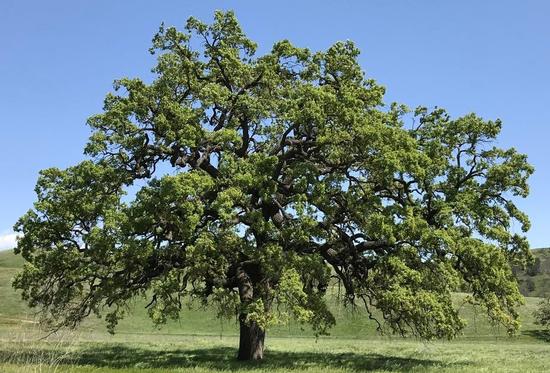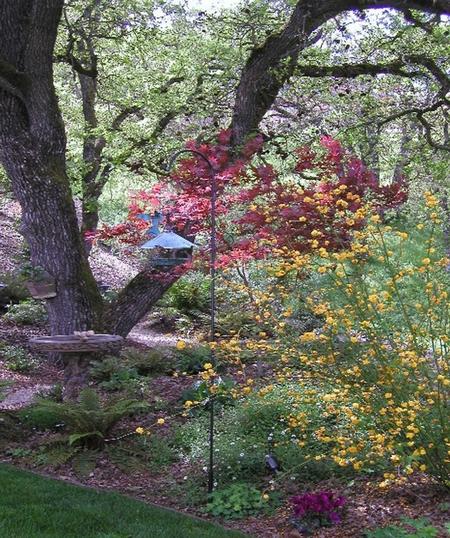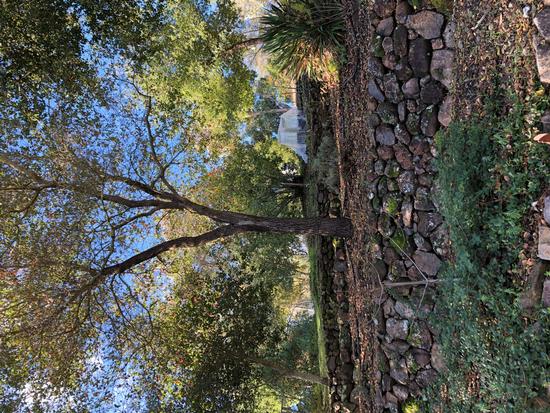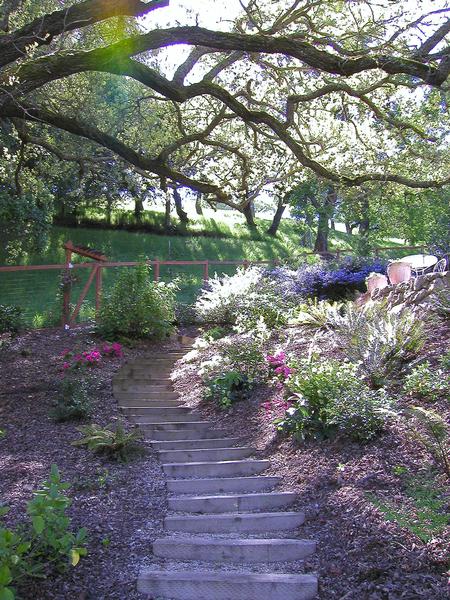Winter 2024
Gardening Under Oaks
by David George
Do you have one or more native oak trees in your yard or would like to plant one? Our local oaks are magnificent and important trees to the Contra Costa ecosystem. They deserve to be treated with respect and care. What are the best practices for gardening under and around native oaks? This article will guide you through the selection process of plants that are beautiful, waterwise, healthy, and complimentary to your oaks.
Our Native Oaks
Oaks are taxonomically called "Quercus," which is Latin for “Fine Tree.". They are called a “keystone” species because they support entire ecosystems. If oaks were to disappear from our region, birds, small mammals, insects, and other creatures that rely upon them would soon disappear as well. Records show that oaks appeared about 65 million years ago, soon after the dinosaur extinction. Individual trees have been known to survive for more than 2,000 years, and a single tree can produce 10 million acorns in its lifetime. That’s a lot of food!
Four dominant varieties make up our local oak population. The evergreen coastal live oak (Quercus agrifolia) is our most abundant and thrives in cooler coastal conditions such as west Contra Costa and the East Bay hills. Further inland, massive valley oaks (Quercus lobata) predominate. These deciduous giants are what we call “heritage oaks” in central county communities. Black oaks (Quercus kelloggii) mix into both regions and produce the world’s largest oak leaves—up to 10 inches long. Hot weather-loving blue oaks (Quercus douglasii) complete our list and are found on the slopes of Mt. Diablo and further east.

Squirrels, bears, black-tailed deer, scrub jays, wild turkeys, quail, flickers, and woodpeckers all depend on acorns for food. Insects feed on the leaves, twigs, acorns, bark, and wood of oak trees (which in turn are food sources for larger critters.) Oaks continue to be useful to the ecosystem even after they die, with salamanders, worms, snails, termites, and ants feasting on decomposing limbs, creating humus, which enriches the soil.
Oaks and Watering
The rule of thumb for watering around oaks is to keep the area under the tree canopy naturally dry during the summer months and to prevent standing water during the wet months. Valley oaks are generally more tolerant of soil moisture than other local varieties. Often, during California's natural cycles of drought, many local oaks show signs of water stress despite their extensive root systems. William Tietje, UC ANR Cooperative Extension Area natural resources specialist, has some good advice for oak tree care during dry years.
“Concern has grown since severely stressed and even dead oak trees are becoming common observances. People are asking, ‘What can I do to help?' Three options come to mind: deep watering, mulching, or doing nothing. If the soil 12 to 18 inches down under your oak is dry and crumbly, the oak is out of water. Deep watering of the drought-stressed tree is accomplished by moving a hose under the canopy of the tree during the day for one or two days at a low flow or trickle, such that the water percolates into the soil. Do this once or twice during the summer to early fall.”

You can also let California’s oaks survive our drought and wet years on their own. Local varieties have adapted over time to California’s sometimes dramatic climate swings. If there is any moisture at all, their roots will find it. In fact, blue oaks merely shut themselves down if they run out of water, losing all of their leaves and appearing dead in summer and fall. After the winter rains, they sprout leaves and look healthy again.
Planting Oaks
If you would like to plant a local oak variety, make sure that soil drainage is good in the planting area, choose a variety that is best for your location (see above), and consider the eventual size of the mature tree. You may not have enough space to support one, and you don’t want it to grow too close to your home. Lightly irrigate your new tree for the first 5 years, then let its roots tap the soil’s natural moisture after that.

Don’t splash irrigation water onto an oak or immediately around its base. Avoid disturbing an established oak’s roots with rototilling or excessive digging. Keep soil and mulch from banking up against the tree base over time to discourage fungi and diseases. And don’t compact the soil under the oak canopy with concrete pathways, driveways, or heavy equipment.
Oaks don’t like severe pruning or “pollarding” of their canopy, but they tolerate “pruning up” their trunk to 6-10 feet above the ground for fire safety. A certified arborist can safely open windows of sunshine and let air flow through the tree’s canopy without risking the oak’s health.
Planting Under and Around Oaks
When you add plantings under and around your oaks, minimize irrigation and sun requirements by selecting drought and shade-tolerant plants. Spacing out the plantings and selecting low-growth varieties avoids competition with the oak’s roots for water and nutrients.

Many horticulturalists advise against locating plantings within 4-6 feet of the oak’s base. Under its dripline, drifts of native bunch grasses work well, such as California fescue, wild rye,blue grama grass, or purple needlegrass (the California state grass). Bulb plants like Douglas irises, sedums, succulents, native ferns, yerba buena, and geraniums are all good additions. Beyond the oak tree’s dripline and shade, complimentary plantings include native perennials such as hummingbird sage (Salvia spathacea), bleeding heart (Dicentra formosa), snowberry, sticky monkey flower, coffeeberry, and elderberry.
For larger gardens, the palette can include native bushes and small trees that coexist with oaks in California wildlands. These include California holly (Toyon), Pacific madrone, manzanita, buckeye, western redbud, California lilac, Oregon grape, common viburnum (Viburnum ellipticum) and Pacific dogwood. Non-native but complimentary drought-tolerant plants include Japanese barberry, andromeda, and Japanese tassel fern (Polystichum polyblepharum).

Avoid selecting plants that are not drought-tolerant, that do not provide habitat or forage for wildlife, are invasive, or add considerable fuel load (pitches and resins) to wildfires. Some examples of these are European-style formal lawns, rose varieties, annuals that require frequent irrigation and fertilizing, or ivies that spread, climb, and steal nutrients.
For more information, you can visit the Oak section of the UCANR IPM website at ipm.ucanr.edu, the californiaoaks.org website.
Resources
How to Grow California Oaks
https://oaks.cnr.berkeley.edu/how-to-grow-california-oaks/
Growing Oaks from Acorns
https://ucanr.edu/sites/ccmg/files/123756.pdf
Planting Under Oaks, UC Master Gardener Program of Sonoma County
http://sonomamg.ucanr.edu/Planting_Under_Oaks
California Oaks, a project of the California Wildlife Federation
https://californiaoaks.org/
